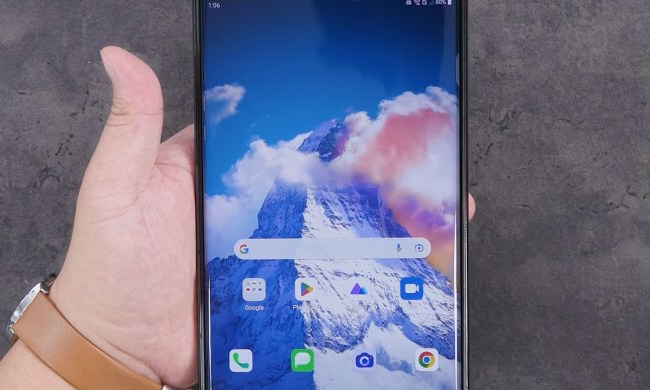“... the CU500's camera produces some of the best 1.3-megapixel pictures we've seen...”
Pros
-
HSDPA/EDGE world phone; solid MP3 player; landline voice quality
Cons
-
MicroSD card slot located behind battery; no USB cable included; short battery life
Summary
If you’ve ever felt the need for cell phone speed, your previous choices have been either Sprint or Verizon’s EV-DO. EDGE networks from Cingular and T-Mobile simply didn’t measure up. But Cingular has launched its High-Speed Downlink Packet Access (HSDPA) broadband network in around 20 major U.S. markets, bringing EV-DO-like 400-700 kbps speed to the GSM world.
Cingular’s first HSDPA phone is the LG CU500, available for the bargain price of just $79.99 with a contract and rebates. Not only does the CU500 bring broadband speed for Web surfing, it powers Cingular Video (a TV-clip service that includes exclusive HBO Mobile content among its copious content offerings) along with MobiTV and MobiRadio streaming TV and radio services. Aside from video, the CU500 is piled high with advanced features and performs mostly as promised, but with a couple of curious design and implementation shortcomings.
Features and Design
As a thin black clamshell, this quad-band GSM/GPRS/EDGE world phone is sure to remind folks of the
Motorola RAZR; at 3.8 by 1.95 by 0.76 inches, the CU500 is roughly the same size and at 3.7 ounces, just .21 ounces heavier. What’s radically different about the CU500 from the RAZR are the front music transport controls and external access to the camera/video recorder functions, with the external 1.2-inch screen serving as a viewfinder. Up top is the camera, mounted in a swivel barrel that rotates 180 degrees. The earpiece is actually a stereo speaker array.
Highlighting the cleanly laid-out, well-spaced keypad and navigation array inside the clamshell is a unique and handy soft-key “My Menu” button, oddly labeled "Options" on-screen. Listed in this “My Menu” menu are direct access to Bluetooth, calendar, instant messaging, Cingular Video, and alarm clock, as well as seven more unassigned slots. There are also dedicated music and camera keys.
But LG giveth and LG taketh away. Instead of the usual side slot, the microSD flash memory card slot is located underneath the battery. This location is especially awkward since the only way to get music into the phone is to insert the card in its adapter into a PC and drag-and-drop tracks from your own collection. A USB cable is available only as a $25 option, and at press time, Cingular hadn’t yet opened its online music store. Bluetooth is too slow to be a viable mass music transfer option. All this means that you have to power down the phone every time you want to get the card to load it up.
Cingular offers a wide variety of subscription video options including Cingular Video and MobiTV and MobiRadio. There are also a couple of games included, such as the addictive Tetris, along with four instant messaging options (AOL, Yahoo!, ICQ, and MSN), and the by-now expected group of convenience applications—alarm clock, calendar, notepad, calculator, tip calculator, world clock, to-do task listing, and a stop watch, along with three unique apps: a unit converter (imperial-to-metric), a date finder (which calculates the date in X-number of days from a specific date), and a D-Day counter (the functionality of which escaped us).
 Image Courtesy of LG Electronics
Image Courtesy of LG ElectronicsPerformance
You’re buying this phone for speed, and it is speedy—but not compared to its EV-DO competitors. In our admittedly unscientific tests, the CU500 was a hair slower loading web pages than EV-DO phones from Verizon and Sprint. But these differences are negligible since most pages loaded in three to five seconds and most video clips loaded in less than 10 seconds.
Video from Cingular Video and MobiTV, however, were both superior to Verizon V Cast and Sprint Power Vision video offerings, with crisper, cleaner, and smoother video with fewer buffering pauses. Our only complaint is the lack of a widescreen option as found on V Cast phones.

Musically, the CU500 plays back unprotected MP3, WMA, AAC, and AAC+ tracks. You can choose between two animated "spectrum analyzers" to accompany your tunes or simply a display or track name and artist. There’s a real EQ with our favorite 3D Surround, along with Classic, Jazz, Pop, and Rock settings, and you can choose from repeat and shuffle options. There’s a 2.5mm headphone jack but, surprisingly, there is no headset—stereo or mono—included. Fortunately, the Bluetooth Stereo implementation delivers excellent, solid sound with nary a connectivity blip.
As noted, the CU500’s earpiece is comprised of tiny stereo speakers that produce robust sound as a speakerphone and make the CU500 a reasonable-sounding mini-jukebox with the top up or, even better, down. For some reason, the sound is trebly and thin with the top up, but when down, the music’s tone turns richer and deeper. There’s not a lot of volume, but in a quiet work environment, it provides nice background music.
Other than seamless video streaming and Jose Reyes quick data downloads and web page loading, the primary benefit of HSDPA is what LG and Cingular promote as "multitasking." The CU500 spec sheet declares that you "use voice and data capabilities simultaneously.” This is misleading at best, incorrect at worst. If you’re surfing or listening to music or watching Cingular Video and a call comes in, the application automatically pauses. When you end the call, your multimedia application picks up from where you left it. Convenient, certainly, but hardly multitasking.
While the CU500’s camera produces some of the best 1.3-megapixel pictures we’ve seen, getting them out of the phone is problematical. As noted, there’s no USB cable, the prospect of extracting the microSD card is unappealing, and sending your photos via Bluetooth is not nearly as intuitive as it should be — Bluetooth is a "send" option only when your photos are in thumbnail view. Once you choose a picture to fill the screen, you mysteriously lose the ability to send it via Bluetooth.
Assumedly, you will actually use the CU500 to hold conversations, and with near landline voice quality and plenty of volume in both private and speakerphone modes, you won’t be disappointed. But the faster network is a greater power drain, limiting the phone to just 3.5 hours of talk time.
Conclusion
This otherwise outstanding fast and well-designed multimedia phone is almost fatally flawed by its frustrating microSD card slot location, akin to putting the gas tank opening under the rear seat in a car.
Pros
- HSDPA/EDGE world phone
- Superior integrated MP3 player
- Cingular Video, MobiTV applications
- Superior Bluetooth Stereo connectivity
- Convenient 1.3-MP rotating camera
- External music/camera controls
- Landline voice quality
Cons
- Buried microSD flash memory slot
- No included sync cables or earphones
- Difficult to transfer photos from phone to PC

 Musically, the CU500 plays back unprotected MP3, WMA, AAC, and AAC+ tracks. You can choose between two animated "spectrum analyzers" to accompany your tunes or simply a display or track name and artist. There’s a real EQ with our favorite 3D Surround, along with Classic, Jazz, Pop, and Rock settings, and you can choose from repeat and shuffle options. There’s a 2.5mm headphone jack but, surprisingly, there is no headset—stereo or mono—included. Fortunately, the Bluetooth Stereo implementation delivers excellent, solid sound with nary a connectivity blip.
Musically, the CU500 plays back unprotected MP3, WMA, AAC, and AAC+ tracks. You can choose between two animated "spectrum analyzers" to accompany your tunes or simply a display or track name and artist. There’s a real EQ with our favorite 3D Surround, along with Classic, Jazz, Pop, and Rock settings, and you can choose from repeat and shuffle options. There’s a 2.5mm headphone jack but, surprisingly, there is no headset—stereo or mono—included. Fortunately, the Bluetooth Stereo implementation delivers excellent, solid sound with nary a connectivity blip.



